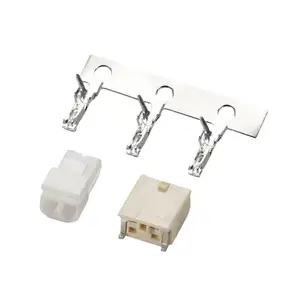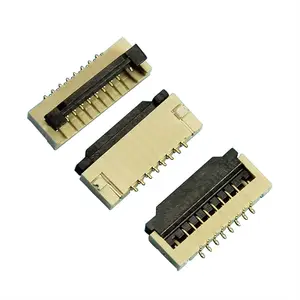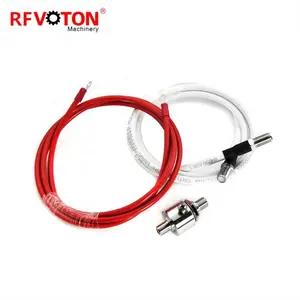Within the realm of electronic components, a connector protector plays a pivotal role in safeguarding connections from environmental hazards and electrical surges. These devices are essential for maintaining the integrity and longevity of electronic systems, particularly in areas prone to electrical disturbances. The connector protector is designed to shield various types of connectors, including those used in data transfer and power supply applications, ensuring that both signal and power are consistently delivered without interference.
Types and Characteristics of Connector Protectors
Connector protectors are not one-size-fits-all; they vary significantly to cater to different needs. For instance, a cable connector protector is typically used to shield cables from physical damage and electrical interference, while an RJ45 connector protector is specifically designed for network cables, providing both physical barrier and surge protection. The lightning arrestor N type is another specialized type, designed to protect antenna systems and RF equipment from lightning-induced surges. Each type of connector protector has its unique characteristics, such as varying clamping voltages and different levels of surge protection, tailored to the specific application it is designed for.
Structure and Operation of Connector Protectors
The structure of a connector protector is a complex assembly of components working in harmony. At its core, you might find a gas discharge tube for handling high-energy surges, paired with a diode array for finer protection against lower-energy events. The physical design includes a robust casing, often with IP-rated weatherproofing for outdoor applications. Inside, the arrangement of components is meticulously engineered to provide a clear path for surges to be safely diverted to ground, away from sensitive electronics.
Materials and Properties
The choice of materials in a connector protector is critical for its performance and longevity. Conductors made from tinned copper offer excellent conductivity and are less prone to oxidation, while pure copper provides unmatched electrical performance. The external materials, such as aluminum alloy, are selected for their strength-to-weight ratio and corrosion resistance, which is vital for outdoor or industrial environments. Nylon braid and zinc alloy not only contribute to the physical durability but also add a layer of electromagnetic interference (EMI) shielding, enhancing the protector's overall effectiveness.
Business Usages and Applications
In the business realm, connector protectors are indispensable across various sectors. In telecommunications, for example, RJ45 lightning protection is crucial for maintaining the integrity of network infrastructure. In the energy sector, lightning protection connectors are employed to protect electrical substations and renewable energy installations. These protectors create business value by preventing costly downtime and equipment failures, thereby ensuring continuous operation and reliability.
Functions and Tasks
A connector protector is designed with a clear purpose: to shield electronic systems from voltage spikes and surges. It functions by either blocking, grounding, or shorting to ground any unwanted voltages above a safe threshold. This protection is not limited to lightning strikes but also encompasses other surge events, such as those caused by switching or electrostatic discharge, ensuring that the connected devices can operate without interruption or damage.
Features and Capabilities
The distinct features of a connector protector include its response time, energy dissipation capacity, and the specific frequency range it can protect. For instance, an ATT3G50HP model might boast an ultra-fast response to surges, making it ideal for high-speed data environments. Unique selling points such as compact design for space-sensitive applications or modular construction for easy maintenance set certain protectors apart from their competitors.
Benefits and Positive Outcomes
The benefits of using a connector protector are manifold. They provide peace of mind by ensuring that critical systems are not compromised by electrical surges. This translates to fewer equipment failures, reduced maintenance costs, and improved safety for both the equipment and its operators. For businesses, this means uninterrupted service and reliability, which are crucial for maintaining customer trust and satisfaction.
How to Use and Operate Effectively
Effective operation of a connector protector involves correct installation at the point where cables enter a building or device. It's important to match the protector's specifications with the system's requirements, such as voltage and current ratings, to ensure compatibility and protection efficacy. Regular testing with appropriate equipment is recommended to verify that the protector remains in good working order.
How to Choose the Right Model
Selecting the right connector protector requires an understanding of the system's needs, including the type of connectors in use, the electrical specifications, and the environmental conditions. For example, a lightning protection N female to N male device would be chosen for its compatibility with RF connectors, while the selection of an electrical connector protector for a data center would focus on data throughput and bandwidth considerations.
Guidelines for Cleaning, Maintenance, and Installation
Cleaning a connector protector typically involves removing any debris or buildup that could impede its function. Maintenance checks should include inspecting for corrosion or wear and testing the device's protective capabilities. Installation must be carried out in accordance with the manufacturer's instructions, ensuring that the protector is properly grounded and securely connected to both the system and the earth ground.
Target Audience and Meeting Needs
The target audience for connector protectors includes industries where reliability and uptime are non-negotiable, such as healthcare, finance, and telecommunications. These products meet the needs of these sectors by offering reliable protection against unpredictable electrical events, ensuring that critical systems remain operational and data integrity is preserved.
What are the key considerations when integrating a connector protector into an existing system?
When integrating a connector protector into an existing system, key considerations include compatibility with the connectors in use, the electrical specifications of the system, and the environmental conditions where the system operates. It's essential to ensure that the protector's specifications, such as voltage and current ratings, align with the system's requirements to provide effective protection.
How does a connector protector enhance system reliability?
A connector protector enhances system reliability by mitigating the risk of damage due to electrical surges and spikes. By absorbing or diverting excess voltage, a lightning protection connector prevents this energy from reaching sensitive electronic components, thereby reducing the likelihood of failure and ensuring consistent system performance.
What are the maintenance requirements for a connector protector?
The maintenance requirements for a connector protector typically involve periodic testing to ensure it is functioning correctly. This may include checking the continuity of the protective paths and inspecting for any signs of physical damage or degradation. For devices like the lightning arrestor N type, it's also important to check the grounding system regularly to maintain effective protection.
Discover a wide range of connector protectors on Alibaba.com, each designed to meet the rigorous demands of protecting electronic systems from electrical disturbances. Whether for industrial, commercial, or personal use, these protectors are an essential component in safeguarding your electronic investments.












































 浙公网安备 33010002000092号
浙公网安备 33010002000092号 浙B2-20120091-4
浙B2-20120091-4